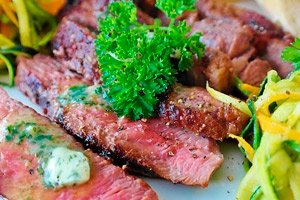
All iLive content is medically reviewed or fact checked to ensure as much factual accuracy as possible.
We have strict sourcing guidelines and only link to reputable media sites, academic research institutions and, whenever possible, medically peer reviewed studies. Note that the numbers in parentheses ([1], [2], etc.) are clickable links to these studies.
If you feel that any of our content is inaccurate, out-of-date, or otherwise questionable, please select it and press Ctrl + Enter.
Red meat contributes to the development of atherosclerosis
Last reviewed: 02.07.2025
 ">
">The presence of red meat in the diet causes increased intra-intestinal reproduction of the bacterium Emergencia timonensis. This microorganism is known for the fact that in the process of its metabolism a substance is produced that contributes to the development of pathologies of the cardiovascular system. This information was voiced by employees of the clinical center in Cleveland. They published the results of the study on the pages of the Nature Microbiology edition.
We are talking about the results of long-term scientific work initiated more than ten years ago. In the first stages of the study, scientists discovered one of the main by-products of bacterial processing of red meat and other animal products. It turned out to be trimethylamine-N-oxide - a substance that greatly increases the risk of developing cardiovascular pathologies and cerebrovascular disorders.
About three years ago, researchers discovered that under the influence of certain intestinal processes, the amino acid carnitine is transformed into trimethylamine-N-oxide. At the first stage, an intermediate substance, γ-butyrobetaine, is formed, which, under the influence of the intestinal microbiome, is converted into trimethylamine, a precursor of trimethylamine-N-oxide. As scientists explain, there are a large number of microorganisms in the intestine that are capable of transforming carnitine into γ-butyrobetaine, but not everyone can transform it into trimethylamine.
The experts traced the relationship between the level of trimethylamine-N-oxide and the development of cardiovascular pathologies. To collect evidence, they analyzed the composition of the blood and intestinal microbiome of three thousand participants, additionally studying their dietary preferences. It was found that the intestines of the subjects who preferred red meat were abundant in Emergencia timonensis microorganisms, which contribute to the unsafe transformation of γ-butyrobetaine into trimethylamine and then into trimethylamine-N-oxide. In addition, volunteers who ate meat had an increased tendency to form atherosclerotic plaques and intravascular thrombi. But in the intestinal microbiome of people who adhered to a vegetarian and vegan diet, these microorganisms were found in minimal quantities or were completely absent.
As the participants switched to a predominantly plant-based diet, a decrease in the number of unsafe intestinal microorganisms was noted. This only indicates that the correction of dietary habits and preferences will help minimize the risks of developing cardiovascular pathologies and complications of these diseases. This discovery can also be used as a preventive measure against atherosclerosis, heart attacks, strokes, and heart attacks.
Details are described on the NATURE source page
